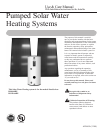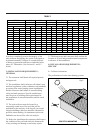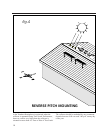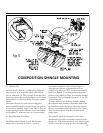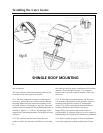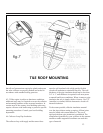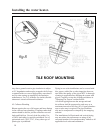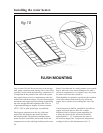
7
PREFACE
Let us rst offer two words of grateful appreciation.
Thank You! We sincerely appreciate your business.
Rheem also wishes to say thank you for "going
solar". Solar water heating systems help to reduce
our nation’s dependence on polluting fossil fuels,
minimize the greenhouse gas emissions associated
with conventional water heating and, very
importantly, lower your monthly utility costs.
Your Rheem solar water heating system has
been designed to meet exacting SRCC OG-300
certication requirements. The components found
in your system have been selected for their proven
reliability, longevity and performance in your specic
region of the country.
1) INTRODUCTION
Solar water heating systems are climate and site
specic appliances. Different types of solar systems
are installed around the world in accordance with
regional weather and water quality conditions. System
performance varies as a function of the household
hot water load, including daily showers, laundry and
kitchen uses, average ground water and ambient air
temperatures, the home’s roof pitch and orientation,
and, of course, the seasonal intensity of solar
radiation. These variables, some of which change
from home to home on the same neighborhood street,
will determine how much energy and money your
Rheem system will save on an annual basis.
Your Rheem solar system is known as a "forced
circulation" system because it utilizes a mechanical
pump to efciently circulate the Dow Chemical
Dowfrost HD propylene glycol heat transfer uid
(HTF) throughout the system. The HTF protects the
collector piping from freezing and inhibits scaling
deposits that can reduce performance in "open-loop"
systems utilizing potable water as the HTF. Proper
application and maintenance of the HTF can protect
your Rheem solar water heating system to minus 30°
Fahrenheit.
This manual is intended as a basic solar water heating
primer. Our goal is to familiarize you with the proper
installation, operation, and maintenance of your
Rheem solar system. This system is required to be
installed by properly licensed solar or plumbing
contractors in accordance with SRCC Standard OG-
300 and all applicable national, state and local codes,
ordinances and regulations governing solar water
heating installations, as well as good trade practices.
Failure to follow the procedures and practices
described in this manual can void the manufacturer's
warranty for specic component parts.
This manual covers installations utilizing two
Rheem solar collectors with a single solar storage
tank and also two tank systems that include a solar
storage tank and a conventional water heater. For
simplicity, the singular form will be used throughout
this manual when referring to all of these components
and system permutations. Frequent reference is made
throughout this manual to specic component parts.
The placement of each component can be seen in
system schematic gures 16 and 17. A description of
each component and its function is found in Section
10.
2) SYSTEM DESCRIPTION AND
OPERATIONAL PRINCIPLE
The key components in the Rheem solar water
heating system include the solar collector, solar
storage tank with integral heat exchanger, circulation
pump, differential thermostat, expansion tank,
pressure gauge, mixing valve and the non-toxic
propylene glycol heat transfer uid (HTF).
The Rheem solar collector is the heart of the system.
Simply stated, when the sun is shinning, heat energy
is absorbed by the solar collector’s all copper
absorber plate and tranferred to the HTF circulating
through the solar collector. The system pump
efciently circulates this heated uid through the
collector piping and integral tank heat exchanger. As
the HTF passes through the heat exchanger the heat
in the uid is transferred by conduction to the potable
water in your solar storage tank. As this process is
continuously repeated during the average sunny day
the temperature in your solar storage tank rises.
When the solar collector absorber plate is
approximately sixteen degrees hotter than the
temperature in the bottom of your solar storage tank,



